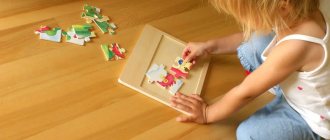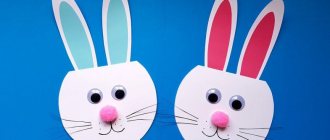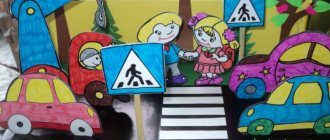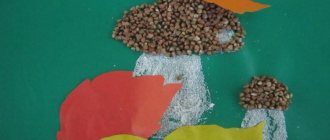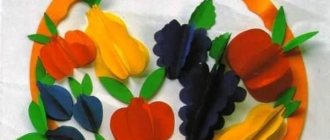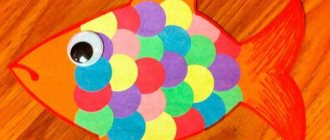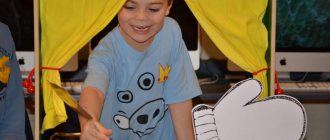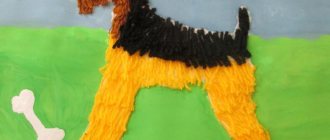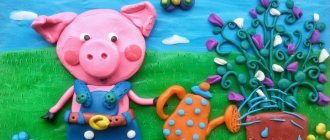Yulia Karateeva
Summary of the educational situation on the application on the topic “Tools”
Collaborative educational situation
teacher with preparatory group children
Topic: " Tools
»
Goal: Create conditions for consolidating and generalizing knowledge about working tools and their purpose
.
Tasks :
Educational
: clarify, expand and activate children’s vocabulary on the topic “Tools and
tools
;
consolidate the ability to cut a strip folded in half (several times)
to obtain a symmetrical shape, figures of the same size; consolidate the ability to cut a circle from a square, an oval from a rectangle
Educational: develop children's creative imagination
, attention, observation, ability to make logical conclusions; develop the ability to coordinate your actions with the work of the entire team
Educational: cultivate a sense of goodwill, responsibility and cooperation; to form a positive attitude of children towards the teacher and towards each other.
Methods and techniques:
Visual (show, demonstration)
;
Verbal (literary word, conversation, question-answer)
;
Gaming (didactic game)
Practical (completing the task)
Pedagogical technologies: socio-game technologies
Materials: Whatman paper, colored paper of different formats and colors, scissors, glue, napkins for work. Toy instruments
: hacksaw, hammer, rake, screwdriver, pliers, thimble,
tool
, letter.
Preliminary work: Reading works: S. Marshak “Master - Lomaster”
,
“How a plane made a plane”
;
examination of tools
;
writing a descriptive story; construction with construction kit parts (with screwdriver, wrench)
Why the application, what benefits does it bring?
The applique can be made on completely different themes and from a variety of materials.
Not only colored paper will be used, but also cardboard; multi-colored fabric and natural materials (seeds, cereals, leaves, twigs, small flowers, etc.) will be an excellent material for creativity.
Vegetables, animals, transport, people are some possible topics for creating an application.
This type of work allows you to develop the student’s general horizons, learn something new, and discover hitherto unknown possibilities and teachings.
That is why such a fun and exciting activity is so popular among children of primary school age.
While working, they try to carefully cut out the object, think about how and where it is best to place it, and then fix it on a sheet of paper. Thus, the children develop their thinking processes, and also develop such qualities as:
- accuracy;
- reasonableness;
- economy;
- creativity.
After all, by creating their masterpieces, children learn to appreciate beauty.
Studying anatomy
Older children will be interested in studying human anatomy using the applique as an example. This game will not only develop fine motor skills and perseverance, but will also introduce children to the structure of internal organs.
Depending on age and level of training, the number of organs may vary. To play you will need:
- template (contours of the human body);
- organs (brain, stomach, lungs, liver, heart, intestines and others);
- diagram with the location of organs on the template and their names;
- glue.
The essence of the game is to introduce the child to internal organs.
- Each organ is taken in turn. Its name is clearly pronounced and shown on the diagram where it should be located. For older children, the purpose of this organ is explained.
- The child takes the organ shown and glues it onto the person’s stencil for appliqué.
- The actions are repeated with each organ.
If this is not the first time an acquaintance with the internal structure of a person occurs, then the child can be asked to independently glue the organs onto the template.
Applications for 1st grade
For the youngest children in school, so that they quickly adapt to a different mode of work, it is necessary to think through the lessons in a fun and interesting way; this is where technology lessons come to the rescue, where you can make a variety of crafts. For work it is best to use:
- colored paper;
- multi-colored cardboard;
- pencils of different colors;
- scissors;
- glue.
If you offer them an interesting topic, they will work hard for a long time to create their work of art.
The most important thing in working with first-graders is to be able to organize them for creativity while completely capturing their attention.
A primary school teacher can make connections between subjects, i.e. In the lesson on the world around them, they get acquainted with the topic “Animals of our region”; you can continue to consolidate the material already at work by inviting them to make an application on this topic.
You can diversify the work as follows, distributing animals among students and initially inviting them to make a craft about the character they got.
For the next lesson, they can be asked to prepare an interesting story about an animal, thus preparing a presentation of their work.
Seven-year-old children will perceive this type of creativity well, since they really like to play games and read fairy tales, so they can also be asked to make an application to a work or fairy tale they have studied.
Applications for 2nd grade
Having studied for a year, the children have matured, so when planning lessons it is necessary to take this fact into account. This also applies to labor lessons, where younger students will perform a variety of crafts.
When working with an application, you should complicate the level of execution, otherwise, if it remains at the same level, their interest will quickly fade away, and this cannot be allowed.
To improve children's skills and abilities, you can teach them to make large-scale crafts, starting with the simplest ones.
In addition, every year schoolchildren have an increasing need to understand the world around them; they should be encouraged to show more imagination and try to make their works more beautiful and unique.
And to realize this point, they must read more and study additional literature. That is why you can invite the children to write down important information, in their opinion, in a notebook, making a small note.
Application for 3rd grade
Self-realization of children improves every year. Skills and abilities when working with scissors, colored paper and cardboard must be fully developed.
Therefore, you can safely design lessons in such a way that they contribute to the development of their imagination and fantasy.
Already from the third grade, you can begin to learn other techniques while cutting out objects.
For example, the method of folding a sheet in half or in the shape of an accordion, followed by cutting out the shapes so that they are symmetrical, is perfect for this age.
In addition to cutting, third-graders will enjoy the cutting technique, which is when, instead of the usual work with scissors, they have to work without them - with their hands.
Another fascinating technique is decoupage. It would be interesting if by the end of the school year all the work done by the children was collected and compiled into a catalog of applications.
Movable little man
Patterns of human body parts can make applique more interesting for children. With their help, it is possible to achieve a realistic, bright picture or give it dynamics. Surely older children will enjoy the dynamic applique.
To work you will need:
- templates of body parts (arms, legs, torso, head);
- screws and nuts from a metal constructor;
- cardboard;
- glue;
- scissors.
The work is carried out in several stages:
- Templates printed on paper are cut out and glued onto thick cardboard. This makes them stronger. Then the parts are cut out of cardboard.
- Place your hands on the body and use sharp scissors to make a through hole. A screw is inserted into it and a nut is tightened. I repeat the operation with my legs.
- The head is attached to the body in a similar way.
The little man gains mobility and is ready to play. To complicate the work, you can create additional connections at the elbows and knees.
Applications are a fascinating creativity that develops imaginative thinking, perseverance, and fine motor skills. Working with paper is suitable for children of all ages. Having mastered the skills of appliqué on paper, you can move on to more interesting and complex activities - for example, creating a reusable game with felt Velcro.
Applications for 4th grade
Fourth graders, due to their age, have the ability to work with scissors and can draw and paste images well. At this age they should be masters at making appliques. Their work should have a creative, creative approach.
With 4th grade students, you can easily plan work according to a template, give them the task of cutting out identical shapes much faster if they had done it before.
In addition to lesson activities, you can begin to practice doing crafts at home together with your parents.
At home, with the help of mom or dad, children will be able to create something unusual and original; they will be able to try to make applique based on the experience of their parents.
It is this kind of joint work that will help you have a pleasant time together and unite even more in solving the task at hand.
In the future, you can take this pastime as a basis and, for example, invent a new masterpiece together with your child every week, constantly improving your skills.
For example, you can try to make a Christmas tree appliqué, which will consist of geometric shapes.
To make it, take three green triangles and glue them so that one is located above the other. Or make a snowman, for this you will need completely identical circles, which are also glued, like the triangles on the Christmas tree.
The most important thing is to correctly direct the thinking of a junior schoolchild, then in the future it will be much easier for him to navigate the world around him.
If from an early age they develop visual thinking, then in the future this will help him professionally, because it is most valuable in such professions as an architect, designer, artist, engineer, etc.
Also, working with technology, it is impossible to imagine a clean workplace, without a bit of garbage, so by learning to clean it up every time the work is completed, the guys learn self-discipline.
By creating a new application, the guys express themselves, they are looking for something new and unique, something that will make their craft stand out from others.
They begin to see the beauty of the world better, thereby improving their aesthetic taste.
Doing applique does not mean that in the future the child will become an artist or designer, he will just do what he really likes. Just support him in this, be there.
What activities should you do with your child to teach him appliqué?
First give him a strip of paper and help him make the grass, that is, the cuts. From another strip you can make bricks or cubes. To do this you need to cut the strip completely.
Teach your preschooler to use glue, both liquid and solid. Show that glue can be applied to paper in different ways. You can glue the paper completely and along the edges and with dots.
Then you can move on to more complex figures. Teach him to cut out the shapes that make up most objects. For example, a triangle can be obtained by cutting a square diagonally (you get a sail). A trapezoid will turn out if you cut off the corners of a rectangle (you will get the roof of the house). A circle can be obtained if the corners of a square are gradually cut off by rounding (this is how you can get the sun or an apple). That is, strive to turn all activities into an entertaining game.
When folding paper, children do not pay attention to the position of the corners of the sheet of paper. You need to show the children that it will be correct to fold the corners and then use your fingers or palms to follow the fold line. Pay attention to this point.
The application has several stages of work, each of which is performed in turn. Before cutting, it is very important to see in your mind what the end result will be. Only after this you need to start cutting. You may even have to sketch out the outline of the image first. And you need to cut it out of a piece of paper that fits either in size or shape to the image that you have in mind. And already working with scissors, children should imagine what should happen. To develop such abilities in children, offer them tasks with obvious solutions. For example, if you give a child one small square of paper and one rectangle and ask him to cut out a pear and a berry, then he should imagine the result himself and realize that it is easier to cut a pear from a rectangle, and a berry from a small square.
